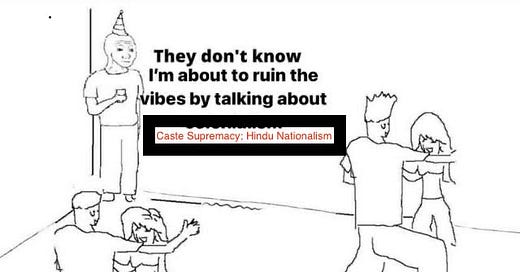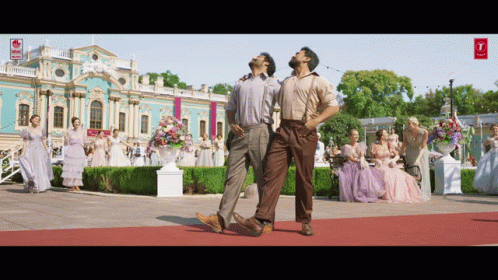Let's Talk about RRR
Entertaining & Captivating -- With some Caste Supremacy and Hindu Nationalism Baked In
So many folks have asked me about RRR - one of the biggest Indian film hits in history both at the Indian box office and on Netflix where it’s now the most-watched non-English language film. Its song “Naatu Naatu” just won the Golden Globe and Critics Choice awards for Best Original Song.
Random trivia note: this song was filmed in front of Ukraine President Zelensky’s official residence in 2021
It won Critics Choice award for Best Foreign Language Film earlier this month. While it’s not India’s official submission to the Oscars, many hope it will receive multiple Oscar nominations tomorrow. Folks love the over-the-top action, dancing and singing sequences, and find it joyful and fun (despite lots of violence and not great things happening) - no matter the 3 hour running time! AND IT’S ANTI BRITISH COLONIALISM so it’s also PROGRESSIVE!

So Let’s Talk about RRR
So let me say first, I get it. If you didn’t grow up with these types of movies then seeing one is a unique and fun experience. RRR is unique in a NON INDIAN movie-going context. And when you throw in the many feel-good scenes where the evil British colonizers are taken down, it gets better.
However, RRR is NOT breaking new innovative ground in Indian moves, with the exception of its huge budget and international reach.
It’s worth noting that these Indian movie staples (singing, dancing, over the top action sequences, epic story and epic length) were for decades the source of mocking of Indian films in the “global north/west” as non-serious films - but that’s a whole other newsletter.
For me personally, this movie is #NotMyGenre when it comes to Indian Films, and I have heard hundreds of better original songs in the history of Indian cinema. The choreography however in “Naatu Naatu” is excellent and fun to watch.
It’s been said many times that all art, all film, is political. Despite what seems like just whimsical romances, colorful and spontaneous dance sequences, and comically absurd action scenes, mainstream Indian cinema is no exception. Rather, due to caste oppression and Hindu nationalism, all choices a director makes in film – names, accents, foods, settings, dialogues – can be read as politicized. Although many Western audiences, unfamiliar with the complexity of Indian political culture and society, may view mainstream Indian cinema as pure entertainment devoid of politics or propaganda, it could not be farther from the case. - Rajamouli’s RRR – Saffronisation and Subtle Hindutva
Indian Film 101
RRR is a huge Indian film industry hit. You’ll notice I don’t say Bollywood, because that is the Hindi language film industry based in Bombay(Mumbai). RRR is a Tollywood movie (Telugu language) and RRR was released in Indian theaters in 5 major languages including Hindi last year, and then released on Netflix where it has thrived.
India has 22 languages mentioned in its constitution and there are over 100 more languages in the country so using Bollywood as one-off for all Indian movies is incorrect and also short shrifts the very long and deep history of movie making in South India (Tamil, Telugu, Malayalam and Kannada language movies).
All of which brings us to the current moment in India. Since the ascent of Modi and the BJP, the country has descended into a nightmarish climate of fear and oppression, wherein religious minorities are under threat, Islamophobia is at an all-time high, bigotry runs free, the rich grow richer, the poor grow poorer, and Adivasi lands and rights are violated. History itself is under threat and is in the process of being rewritten, from disinformation in the media to alterations to education in schools…
This is the context in which RRR was released. And while it might be an exciting romp, the film doesn’t offer any reprieve from the upper-caste vision that brought us here. - RRR is an Incredible Action Movie with Seriously Troubling Politics
Societal Context
India, like many countries including the United States, is in the midst of an intense and dangerous move to fascist nationalism, in this case Hindu Nationalism (Hindutva) which brings with it caste supremacy, anti Muslim, Christian, Sikh, and anti-Adivasi (indigenous) policies and rhetoric. And many of the big budget hits in the past decade have been supporting this movement and getting big support by the ruling government of Prime Minister Narendra Modi and his Hindu Nationalist Party, the BJP.
RRR is about a fictionalized friendship (it’s fan fiction!) of two very real freedom fighters in pre-independence India - Alluri Sitarama Raju and Komaram Bheem. Raju was an upper-caste man who supported Adivasi (tribal and indigenous communities of India) rebellions, while Bheem was an Adivasi revolutionary from the marginalized Gond people.
It may not trade in the “demonizing” creed of casteism, but it trades that for the more “benign” and “liberal” vision of the casteist lens. It is why you have Ram uplifted as the “well-educated upper-caste savior with a vision” and Bheem reduced to “uneducated noble savage who must be taught the ‘civilized’ ways.” For all that it claims to be a tribute to two legends, it is one that is deeply unequal…And it is also why, in the end, Bheem’s real revolutionary slogan of “Jal, Jangal, Jameen,” his iconic contribution, which is vital to Adivasi activism to this day, is altered to be written and inscribed instead by the upper-caste Kshatriya hero Ram. It is, as Gond journalist and critic Akash Poyam described in depth, deeply dehumanizing and appropriative. - RRR is an Incredible Action Movie with Seriously Troubling Politics
The Director adds to this caste supremacist foundation a layer of Hindu mythology (referencing the Hindu epics Ramayana and Mahabharata). Ruling Hindu Nationalists and their supporters, in India and the diaspora, can come together and say that RRR and its international accolades are a matter of INDIAN/HINDU PRIDE - at least according to those who believe that Indian = Hindu.
Every country has its national myths – the beliefs and narratives that serve as the foundation of its national identity. These myths find expression through a nation’s culture. A perennially popular form of this is cinema, and the most potent is the propaganda war film…the common characteristics of nationalistic war movies: the importance of brotherhood, the nobility of sacrifice, nostalgia for an imagined past, limited and/or underdeveloped female characters, and unintentional homoeroticism – all those classic tropes proven for blockbuster success. Their massive popularity comes for the most part from being legitimately good films (in terms of action and spectacle, they are all almost perfect, in terms of writing … eh), but that doesn’t mean we should ignore how these films reach their domestic audiences by reinstating distinct nationalist myths. - Nationalist Propaganda at a Screen Near You
At one point Bheem, on of the two leads, actually says “I am a Tribal. I didn’t understand,” reaffirming stereotypes of Adivasis as uneducated and must be guided by those “better” than them. He says this to Raju’s love interest Seetha (an underused/underwritten Bollywood star Alia Bhatt who is also representing an ideal in a colorist world of a light-skinned woman). Raju is elevated in costume, lighting and props (bow and arrow) to look like Lord Rama, while Bheem is relegated to a supporting player. I even noticed that Bheem was always at least one step behind Raju in running, fighting and racing scenes - like you can’t be equal or ahead of the higher/better person!
The film goes as far as to insinuate that Raju and Bheem are the reincarnations of legendary heroes from Hindu mythology, signaling the film’s uncomfortable relationship with Hindutva nationalism. It then delves into casteist themes as the relationship between Raju and Bheem changes from one of equals, to one where the lower-caste Bheem devotes his cause to the upper-caste Raju. He becomes subservient to Raju, and to an idea of Hindu Unity. This demigod-like character can be seen as symbolising the different sectors of Hindu nationalism, one supporting the other to fight for the Indian nation. - Nationalist Propaganda at a Screen Near You
Don’t get me started on how RRR uses a Black character (with no dialogue) to make a superficial, blink-and-you-miss-it point about Black-Brown solidarity. Or how they made sure a white woman was part of team “good folks” so white (meaning global north/ western) audiences could see themselves in the story and not just as evil colonizers.
Many people say, “relax,” or “just enjoy.” Sometimes the more you know, the less enjoyment there is. And luckily there is plenty more to enjoy in this world, and in Indian Cinema.
So What Does This All Mean?
I acknowledge that the uplift and accolades of RRR without critical thought and reflection are DANGEROUS especially to marginalized people and communities in India and the diaspora.
I acknowledge that when I see the RRR accolade train especially amongst “global north/western” cultural critics that have progressive bona fides - it’s the problem o “one story” narrative for communities, countries and people. In this case, the British are bad and nothing else needs to be known about the context.
I acknowledge that I don’t want RRR to win awards and represent India in the global world, because that means that Modi and his Hindutva movement will be spurred on in their policies and rhetoric. Frankly the accolades so far have already accomplished this. I could write a whole other newsletter on how Indians (in the diaspora as well) continue to chase the love and affirmation of the colonizer.
And if I’m honest with myself, I have to acknowledge that its popularity both in India, the diaspora, and amongst the “western/global north” audiences, is also a true reflection of how this world works - that those with/in power will work together across cultures to secure the status quo without critical thinking.
So if you watch it, take this context and note how it shows up in the movie, how people talk about the movie and which folks get defensive when discussing this context. And most importantly, think about what it means for the millions of marginalized and historically oppressed people in India and the diaspora who see their history, their communities and their stories being warped for a movement that only seeks to harm them.
Want to Understand More? RRR
'RRR' Is the Blockbuster of the Summer, but Mind Its Dicey Politics
RRR is an Incredible Action Movie with Seriously Troubling Politics
How Blockbuster Films are Aiding the Hindutva Nationalism Project
A Wild Indian Blockbuster Is Ravishing Movie Fans, but They’re Missing Its Troubling Subtext
Identity Theft: SS Rajamouli’s Dehumanising Portrayal of the Gond Community
Want to Understand More? Caste Supremacy
I have been on a journey the past many years on identifying and understanding how Caste Supremacy and Caste Privilege has shaped my own experiences and assumptions. It’s impacted everything. Where South Asians go in the world, we take Caste with us.
Equality Labs: Join their organization, and attend their workshops and read their amazing resources about Caste in United States
The Trauma of Caste: A Dalit Feminist Meditation on Survivorship, Healing, and Abolition by Thenmozhi Soundararajan (the founder of Equality Labs, also worth following them on Social Media.
Caste Discrimination Exists in the U.S., Too—But a Movement to Outlaw It Is Growing
Rare Caste Bias Case Advances, Raising Calls for Federal Action
Want to Understand More? Hindutva







Helpful post
Well-researched, engaging, and full of valuable information.